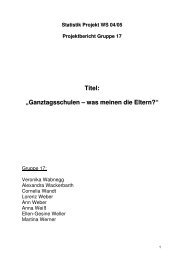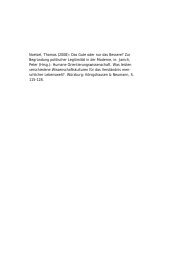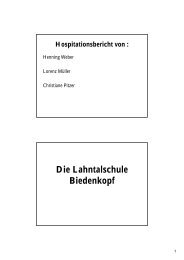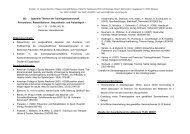of K - Philipps-Universität Marburg
of K - Philipps-Universität Marburg
of K - Philipps-Universität Marburg
Create successful ePaper yourself
Turn your PDF publications into a flip-book with our unique Google optimized e-Paper software.
6<br />
Non-Extant Works Assigned to K¡emendra “Bibliography<strong>of</strong>K¢emendra’sMinorWorks”<br />
The influence <strong>of</strong> Kashmiri Śaivism esp. in the Samayamātkā<br />
Bhatkathāmañjarī, and the<br />
mamālāNar-<br />
has been acknowledged. But K¤emendra was clearly trying to blend the philosophical ideas<br />
<strong>of</strong> Śaivism with those <strong>of</strong> Vai¤avism. He worked eclectically, borrowing doctrines from various<br />
schools and even weaving them into his satirical works, Samayamātkā<br />
e.g. Narmamālā<br />
II.103,<br />
II.112 11 . Most <strong>of</strong> the non-extant works <strong>of</strong> K¤emendra were listed in the introduction by RĀGHA-<br />
VĀCHĀRYA (1961), pp. 10-12, and their position in the inner chronology has been discussed by<br />
<strong>of</strong><br />
STERNBACH (1979), pp. 9 ff. In the īkā<br />
Hemacandra’s (12 th cent.) Kāvyānuśāsanaīkā (Chaps.1-<br />
2) some verses <strong>of</strong> the non-extant works from K¤emendra’s Kavikahābharaa are cited<br />
(Amtataragakāvya, Kanakajānakī, Citrabhāratanāaka, Padyakādambarī) 12 . In Śārgadharapaddhati<br />
(Bombay 1888, No. 3474) I found one verse assigned to K¤emendra, but as STERNBACH<br />
(1979), pp. 9 ff. has shown, some more verses might have been quoted and attributed to Rājaśekhara<br />
and other authors.<br />
Lists <strong>of</strong> Non-Extant Works Assigned to K¡emendra<br />
Amtataragakāvya<br />
In Kavikahābharaa 5.1.50-51;<br />
Avasarasāra<br />
In Aucityavicāracarcā 20 [57];<br />
Citrabhāratanāaka<br />
In Aucityavicāracarcā 31[88];<br />
In Kavikahābharaa 3.2.19; 5.1.43;<br />
In Suvttatilaka 3.16;<br />
In Kavikahābharaa 3.2.23; 5.1.48-49; 5.1.57-58;<br />
Kanakajānakī<br />
Kavikarikā (probably another title <strong>of</strong> Kavikahābharaa)<br />
In Aucityavicāracarcā 2;<br />
Lalitaratnamālānāaka<br />
In Aucityavicāracarcā 21 [66];<br />
In Aucityavicāracarcā 16 [26-27]; 20 [56]; 35-36 [96-98];<br />
In Kavikahābharaa 3.2.22;<br />
Lāvayavatī<br />
In Aucityavicāracarcā 29.84;<br />
Muktāvalī<br />
11<br />
WOJTILLA (1984), BALDISSERA (1999, 2001 & 2005), KIRDE (2001), have focused on citations and allusions in<br />
K§emendra’s satirical poems with reference to Tantrism.<br />
12<br />
For example, Kāvyānuśāsanaīkā in Hemacandra’s Āyurvedaśāstra,<br />
(Bombay 1934, p. 8) the verse “aga candanapaka°” is<br />
cited as an example from whereas in K§emendra’s Kavikahābharaa V. (Bombay 1887, p. 136) the<br />
same verse is cited in “mama padyakādambaryām” as an example for familiarity with medical science.











